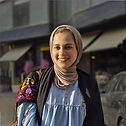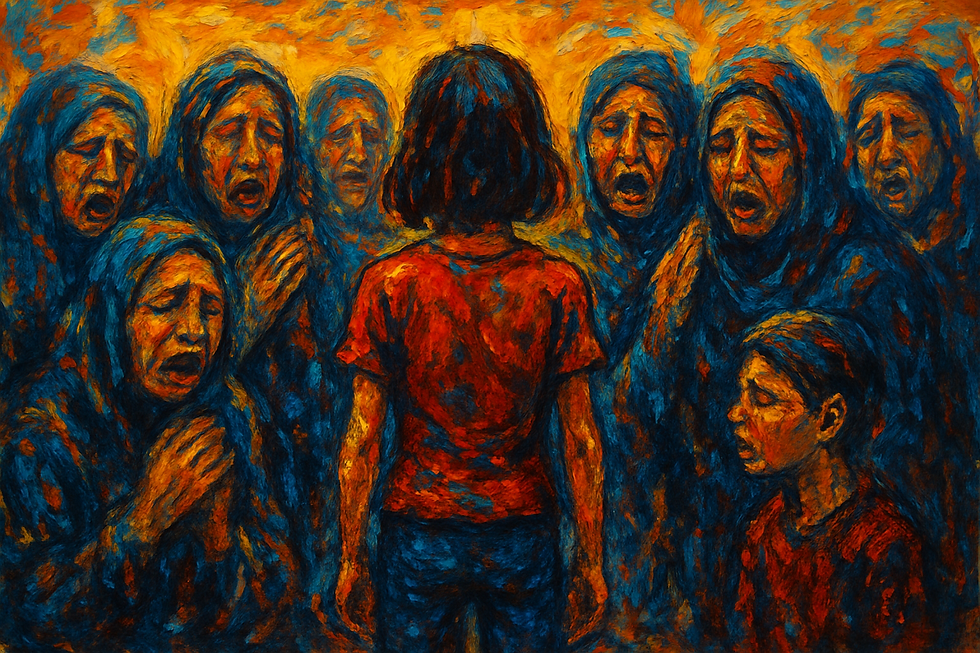How Can a Body Carry an Entire City?
- Maryam Al-Khatib

- 4d
- 4 min read
By Maryam Al-Khatib

In Gaza, memory isn’t written with ink alone, but with blood, with tears, and with the scars that mark women’s bodies. My body, like the bodies of thousands of women here, has become an open notebook where the occupation writes its chapters, on our wombs, on our silenced voices that cry out at night, unable to cross the walls of ruin. When homes are erased from the memory of stone, wombs become the living archive: preserving the names of the martyrs, holding fear, and recounting stories of survival and betrayal.
I sometimes wonder: why was the woman’s body destined to be the first and oldest archive in history? For centuries, women have carried the pain of the first birth and the inherited memory of violence, from the tribe to colonialism, from colonialism to occupation. In every war, ancient or modern, the female body has been the silent battlefield: raped in secret, displaced, stripped of its children, left to carry the shame it never created.
Yet it has also remained an indelible memory, the memory of stories, folk songs, tears of loss, and the smiles of life that bloom amid destruction. Here, the woman’s body is not merely a witness; it is the vessel of collective memory, of place, history, and resistance.
How does a body become a book of history?
I know a mother who gave birth in a tent without medicine or electricity. She says her daughter’s cry blended with the roar of airplanes, making her birth part of the war’s archive. I know a girl who fled with her family but carried her schoolbooks in a small bag, as if she were protecting her dream inside pages that know no borders. I know an elderly woman who still keeps the key to her destroyed home in a cloth bag hanging from her chest, as if she carries the history of the entire city on her shoulders.
These are not individual tales but links in a long chain, the memory of Gaza’s women, inscribed in the body’s details: unassisted childbirth wounds, menstruation in tents without water, scars of hunger, and invisible trauma. Reports indicate that thousands of pregnant women in Gaza have lost access to medical care, and one in ten is at risk of dying during childbirth. Radiation from the bombings leaves lasting effects on the wombs of survivors, causing fetal deformities and recurrent miscarriages. The occupation targets not only the present, but the memory of the future, creating deformed generations before they are even born.
These are not cold statistics, but lives written in blood, slipping through the world’s fingers.
What does it mean to be a woman in Gaza today?
It means living in a time gap. Outside Gaza, women’s rights are discussed in conferences, reduced to slogans of empowerment and equality, while here, women are stripped of their most basic rights, the right to sleep without fear, to give birth safely, to keep their babies alive. Our bodies exist outside the world’s timeline, trapped in the time of occupation and massacres, while “progress” elsewhere is measured by economic and political indicators.
But wombs do not wait for indicators.
They scream. Women give birth in overcrowded schools without water, lose their babies because ambulances never arrived, and bleed to death for lack of a simple medicine. Every womb that lost a child, everybody that couldn’t find a hospital bed, is a page in the war’s archive. Wombs meant to give life now battle death with every birth.
Can one body resist two armies?
Gaza’s women face two forms of violence: the occupation’s bombs, displacement, and siege, and society’s imposed silence and burdens, justified in the name of “steadfastness.” While women bear the heaviest weight of daily survival , finding water and food, caring for the elderly, trying to create a semblance of normal life amid rubble , their presence in decision-making remains marginal, their voices secondary, even though they are the keepers of life and memory.
Even the city itself lives within women’s bodies. Every displaced woman carries in her body the map of a street or an alley. Every mother who lost her home preserves its scent in her voice. Every grandmother who lost a grandchild keeps his name in a song so he won’t be forgotten. When the city is erased from the map, the woman’s body remains the last map, the archive that cannot be bombed.
A friend told me that when she lost her home, she sat among the rubble, gathering shards of broken glass with her hands. She wasn’t searching for anything valuable, only for a trace to prove that this place had been her home. She said, “My house now lives in my body, in my wounded hands. Every shard that pierced my skin became a memory.” This isn’t a metaphor, it’s the truth: bodies preserve destruction just as they preserve dreams.
Why is the voice of women in Gaza always reduced to a scene of tears before a camera?
Because history is written from the victor’s perspective, while women are left in the margins. Yet memory is incomplete without their voices. When we are silent, history is written unfinished; when we speak, the wound becomes memory, and memory becomes resistance.
We don’t need grand speeches, it’s enough to say that the body of a woman in Gaza is no longer an individual body, but a collective memory, a living witness to genocide, an archive that cannot be destroyed. Perhaps that’s why every colonial power seeks to control this body, because it holds truth more deeply than any document. But that truth will continue to be born, with every baby’s cry, with every new scar, and with every song sung in the dark.
Recognizing women’s right to be central voices in memory and justice is not a feminist luxury, it is a condition for survival. For the wombs that have become archives of life and death are the ones telling the world: We are here... and we will not be erased.
Maryam Al-Khatib, Palestinian writer, poet, and activist from Gaza, and a dentistry student pursuing her studies in Egypt after displacement.
The opinions expressed in this article are solely the author’s and do not represent the views of Nisaba Media.





Comments